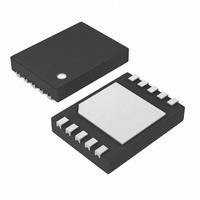DS2781G+ Maxim Integrated Products, DS2781G+ Datasheet - Page 9

DS2781G+
Manufacturer Part Number
DS2781G+
Description
IC FUEL GAUGE STND ALONE 10-TDFN
Manufacturer
Maxim Integrated Products
Datasheet
1.DS2781E.pdf
(31 pages)
Specifications of DS2781G+
Function
Fuel, Gas Gauge/Monitor
Battery Type
Lithium-Ion (Li-Ion), Lithium-Polymer (Li-Pol)
Voltage - Supply
2.5 V ~ 10 V
Operating Temperature
-40°C ~ 85°C
Mounting Type
Surface Mount
Package / Case
10-TDFN Exposed Pad
Operating Supply Voltage
2.5 V to 10 V
Supply Current
70 uA
Maximum Operating Temperature
+ 85 C
Minimum Operating Temperature
- 40 C
Charge Safety Timers
No
Mounting Style
SMD/SMT
Temperature Monitoring
Yes
Lead Free Status / RoHS Status
Lead free / RoHS Compliant
CURRENT MEASUREMENT CALIBRATION
The DS2781’s current measurement gain can be adjusted through the RSGAIN register, which is factory-calibrated
to meet the data sheet specified accuracy. RSGAIN is user accessible and can be reprogrammed after module or
pack manufacture to improve the current measurement accuracy. Adjusting RSGAIN can correct for variation in an
external sense resistor’s nominal value, and allows the use of low-cost, non-precision current sense resistors.
RSGAIN is an 11 bit value stored in 2 bytes of the Parameter EEPROM Memory Block. The RSGAIN value adjusts
the gain from 0 to 1.999 in steps of 0.001 (precisely 2
accurate current measurement. When shipped, the same unique factory gain calibration value is stored in RSGAIN
and in a read only location, FSGAIN (B0h and B1h).The original factory gain value can be restored to the device at
any time by writing the value of FSGAIN back into RSGAIN.
SENSE RESISTOR TEMPERATURE COMPENSATION
The DS2781 is capable of temperature compensating the current sense resistor to correct for variation in a sense
resistor’s value over temperature. The DS2781 is factory programmed with the sense resistor temperature
coefficient, RSTC, set to zero, which turns off the temperature compensation function. RSTC is user accessible
and can be reprogrammed after module or pack manufacture to improve the current accuracy when using a high
temperature coefficient current-sense resistor. RSTC is an 8-bit value stored in the Parameter EEPROM Memory
Block. The RSTC value sets the temperature coefficient from 0 to +7782ppm/ºC in steps of 30.5ppm/ºC. The user
must program RSTC cautiously to ensure accurate current measurement.
Temperature compensation adjustments are made when the Temperature register crosses 0.5
temperature compensation is most effective with the resistor placed as close as possible to the V
optimize thermal coupling of the resistor to the on-chip temperature sensor. If the current shunt is constructed with
a copper PCB trace, run the trace under the DS2781 package if possible.
AVERAGE CURRENT MEASUREMENT
The Average Current register reports an average current level over the preceding 28 seconds. The register value is
updated every 28s in two’s complement form, and is the average of the 8 preceding Current register updates. The
format of the Average Current register is shown in Figure 7. Charge currents above the maximum register value
are reported at the maximum value (7FFFh = +51.2mV). Discharge currents below the minimum register value are
reported at the minimum value (8000h = -51.2mV).
Figure 7. Average Current Register Format
CURRENT ACCUMULATION
Current measurements are internally summed, or accumulated, at the completion of each conversion period with
the results displayed in the Accumulated Current Register (ACR). The accuracy of the ACR is dependent on both
the current measurement and the conversion time base. The ACR has a range of 0 to 409.6mVh with an LSb of
6.25µVh. Additional read-only registers (ACRL) hold fractional results of each accumulation to avoid truncation
errors. Accumulation of charge current above the maximum register value is reported at the maximum register
value (7FFFh); conversely, accumulation of discharge current below the minimum register value is reported at the
minimum value (8000h).
Read and write access is allowed to the ACR. The ACR must be written MSByte first then LSByte. Whenever the
ACR is written, the fractional accumulation result bits are cleared. The write must be completed within 3.515s (one
ACR register update period). A write to the ACR forces the ADC to perform an offset correction conversion and
IAVG
MSb
“S”: sign bit(s)
S
2
14
MSB—Address 08h
2
13
2
12
2
11
2
10
2
9
LSb
2
8
9 of 31
-10
). The user must program RSGAIN cautiously to ensure
MSb
2
7
2
6
LSB—Address 09h
2
5
2
4
Units:
2
3
2
1.5625μV/Rsns
2
R/W
o
C boundaries. The
2
1
LSb
SS
2
0
terminal to











